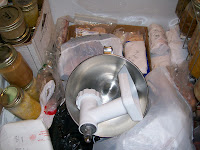 |
| English Pork Pie |
 |
| Freezing equipment |
 |
| In the oven |
 |
| My dinner slice |
Notice how the meat hasn't shrunk hardly a bit from the pastry dough. That made me very happy. I did bake the pie on parchment, just to be sure it didn't stick to the pan. Julia Child recommends lightly greasing the baking sheet underneath the pastry, so I thought I'd be safe with the parchment paper. The paper did slide right out from underneath the pie later on when it had cooled. Notice how I lost a bit of the fat, but not much.
The English Pork Pie is my success. Unfortunately, I rather failed at the Pâté en Croute, which was too bad because I had been so very excited about it!
As soon as the announcement for the September Packing Challenge appeared, I immediately knew I would do the Pâté en Croute, because I had a wild boar tenderloin to substitute for the pork tenderloin. I couldn't wait to begin.
I didn't have a proper terrine, so I substituted with a terra cotta loaf pan. Everything seemed to go well - I even felt comfortable making my own chimney. And into the oven it went. I could smell the cloves in the spice mixture first and the aromas were heady. But by the end of the cooking process, when the fat had broken through the pastry dough in I don't know how many places, panic mode set in.
My first thought was "get rid of the excess fat so it doesn't end up hardening around the outside of the pastry dough." Wrong. Do not throw out the delicious fat, even if it does spread a bit onto the crust because by pouring some of the fat out, I also poured out flavor and binder. This a major mistake and, it turns out, I made several.
I sautéed my wild board tenderloin about a minute or so too long and it became dry in the oven. The forcemeat was not packed tightly enough around the tenderloin. My dough did not cover the pâté correctly and I didn't use enough egg wash. Plus, it broke around the chimney funnel. I also think I may have used a bit too much ground clove. The entire pâté had shrunk too much from the crust. The pâté was a bit dry because I decided not to use the aspic since I didn't know where the crust was leaking.
 |
| Pâté en Croute |
Notice the fat on the bottom of the pastry...which is why I poured out some of the fat...to the detriment of the meat. Luckily, I also managed to turn the whole thing right side up.
Now, that looks better, even without the chimney.
Then I cut my beautiful pastry encrusted forcemeat and my heart sank in direct relation to the space between the meat and the pastry. I felt like crying. But first I had to taste it.
It had a pronounced clove flavor that was too much over the top. I liked it, but it should have been more in the background. The pork, minus that lovely aspic I made, tasted almost dry. The boar tenderloin was definitely dry. Woe was me! What to do, what to do.
I'm the kind of person who, given lemons, makes lemonade, so, first, I cut the tenderloin out of the pâté, for other uses (in risotto, in a ground pork mix, and shaved for a sandwich). I saved some of the crust and the meat for occasional snacking. The rest of the meat I cut into manageable pieces, pressed into a mini loaf pan, poked it about a thousand times with my cake tester, and then poured some of the aspic over the pâté. It became much more moist and the flavor was lush, filling the mouth with flavors from a fairly recent but also remote rural past.
In the end, the pâté tasted rather good. The aspic lent flavor and fat. It didn't look particularly beautiful after such abuse, but it still tasted fine.
I have made pâtés and terrines in the past, but never one covered in pastry. I'm not a big pie eater and for many years I always thought of crusts as just extra calories. But I've learned much from actually doing the Charcutepalooza challenges and in the future, I'll be using these techniques and making this charcuterie much more often. It isn't just a means of preserving food; rather, it has its own elegance and flavors that take me, at least, to other realms of possibilities.











